ILC's Treatment for Intervertebral Disc Degeneration
(Lumbar Disc Disease)
Having been adopted in over 54 countries globally,
the "Cellgel Method" for treating lower back pain
is now available in Japan
For those who have been told it was impossible to operate,
For those who have had recurrence of pain post-surgery,
A low-risk, outpatient treatment is now an option for you.
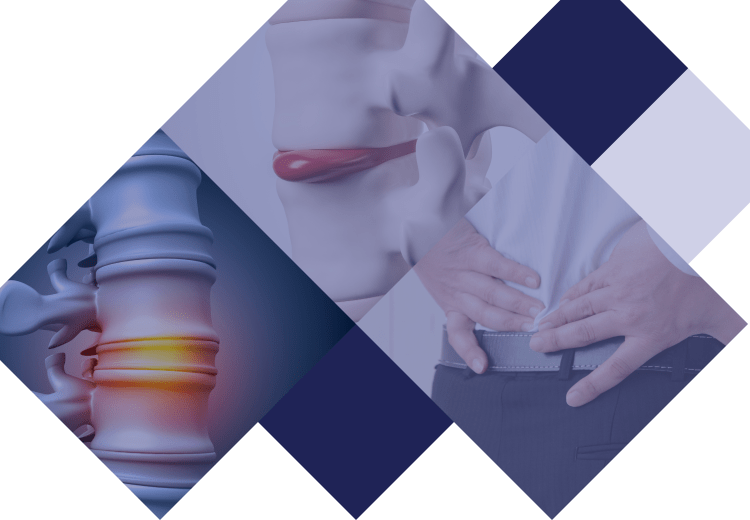
Contents
 Table of Contents
Table of Contents
This page provides information on the main symptoms and causes of disc degeneration and our treatment procedures. The information includes the method of treatment, treatment time, and information about insurance. We use the Cellgel method, which is one of the most advanced methods in the world, and the characteristics of this method are also described in detail.
Please read this page especially if you have been told that you cannot be cured without surgery, if you have had surgery in the past but have not improved, or if you got better after surgery but the symptoms have recurred .
What is disc degeneration?
Between the lumbar vertebrae (spine) is an "intervertebral disc" that sits between the bones. The intervertebral disc is made up of two layers: the annulus fibrosus and the nucleus pulposus.
The annulus fibrosus is composed of alternating fibers and is designed to cushion the impact of movement in any direction. The gelatinous nucleus pulposus is filled with water and aids the cushioning function.
When the intervertebral disc cannot maintain its original shape due to damage or other reasons, it begins to deform, and the function of the disc deteriorates, causing back pain and other symptoms.
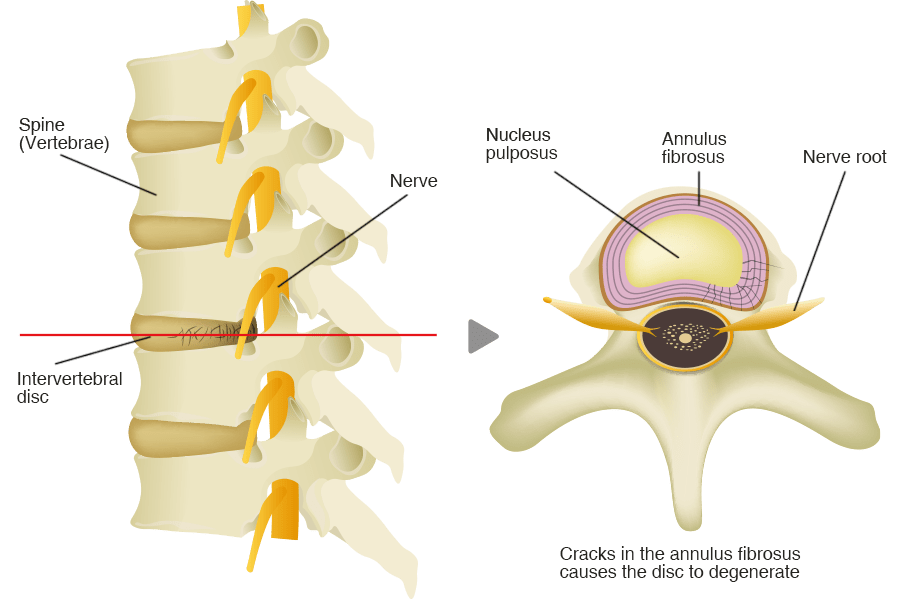
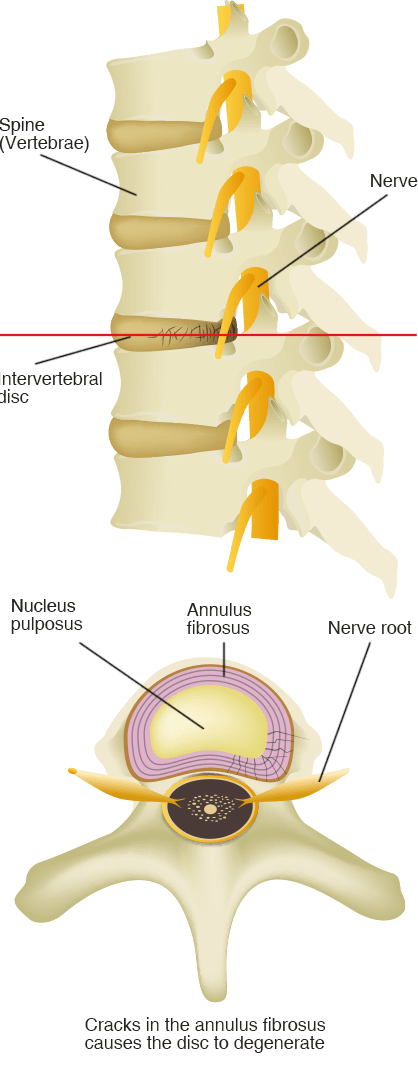
Main symptoms of disc degeneration
The main symptom of an intervertebral disc is considered to be back pain. However, cracks in the disc allows the nucleus pulposus within the disc to leak out, resulting in a herniated disc and nerve damage. The damage causes inflammation of the nerve, resulting in symptoms such as leg pain and numbness.
*Inflammation is a reaction that occurs when the body repairs wounds, causing pain, swelling, fever, etc.
Deterioration of the intervertebral discs results in a decrease in disc height and a closer proximity between bones, making them more prone to collision. Repeated collisions result in the formation of bone spurs called osteophytes and deformation of the vertebral body itself, leading to osteoarthritis of the lumbar spine. This deformity causes inflammation of the bone surface and surrounding tissues, resulting in new pain in the lower back and buttocks, in addition to nerve-related symptoms.
If the inflammation becomes chronic, it may not subside even after surgery because the body becomes hypersensitive to pain due to the accumulation of pain that has built up over time.
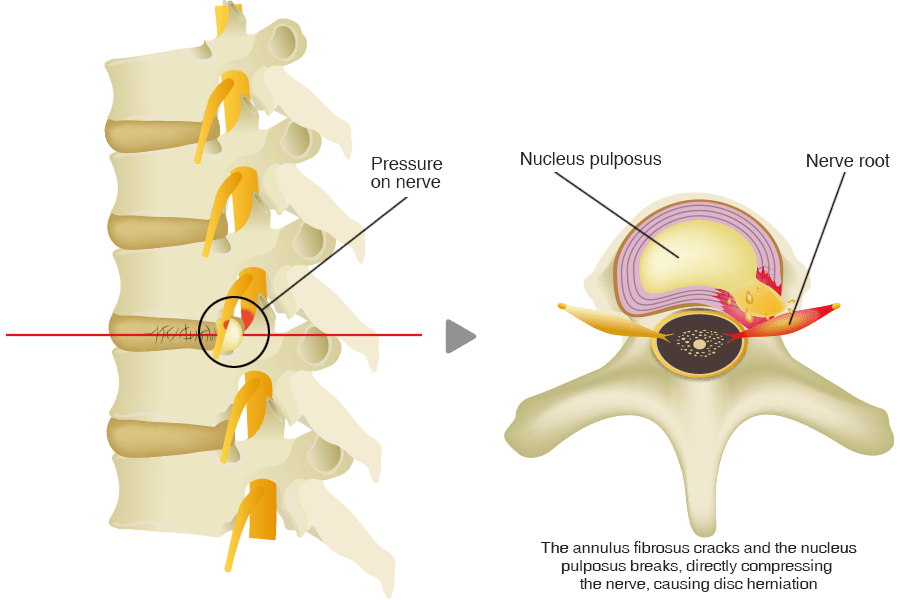
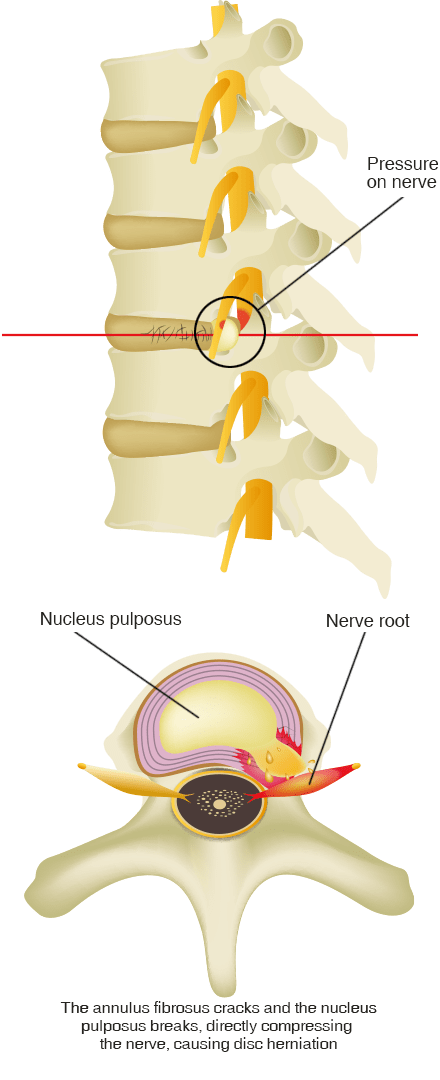
Causes of disc degeneration
Aging, excessive exercise, working environment, and heredity are said to be linked to disc degeneration.
The main component of the intervertebral disc is water. As the body's water content decreases with age, the water content in the intervertebral disc also decreases accordingly. Discs with reduced water content become less supple and more rigid. This causes the disc to crack with the slightest provocation. This is one of the causes of disc injury.
In addition, the disc itself is a "consumable" that cannot be repaired once it is damaged. Exercise or work that puts stress on the disc can accelerate wear and tear on the disc and cause it to deteriorate.
Why is the recurrence rate so high?
Conventional surgical methods relieve symptoms by removing the herniated disc that has protruded, but since the cracks in the disc are not repaired, the disc may herniate again.
This is the main cause of recurrence, which is why it is said to be a disease that is difficult to cure completely.
The Cellgel method used at our clinic injects a drug that fills the cracks in the disc, which then forms a gel that replaces the cracks, thereby providing a fundamental cure to the root cause.
Conventional Surgery

Only the protruding part of the disc is removed via endoscopic surgery.
The damage to the fibers are not repaired.
Cellgel Method
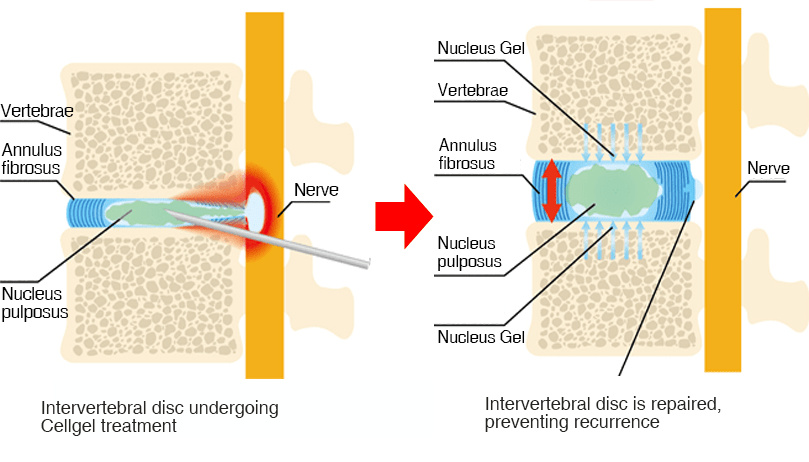
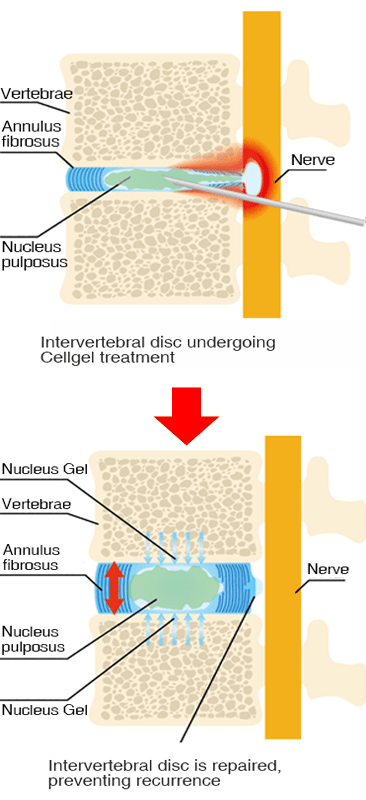
Since many of our patients come from far away,
we are happy to give free consultations to see which treatment is best for you
We'll diagnose your MRI images for free!
Treatment at ILC
There are four main treatments at our clinic.
As mentioned above, the root cause of each back pain disease is "inflammation and deformation due to aging of the intervertebral discs." Although the four treatment methods have different features and advantages, we would like to first introduce the "Cellgel method," which is the only one capable of intervertebral disc repair.
The Cellgel Method
About Cellgel
The Cellgel method is an advanced treatment for low back pain that has been implemented in more than 54 countries worldwide, predominantly in Europe.
As with other treatments, it does not decrease the disc volume, and since the drug remains in the disc as a gel-like implant after treatment, the disc can be preserved. Recent studies have also shown that the volume of the disc increases after treatment.*1
It is also thought that by repairing the disc and preventing leakage of the Nucleus Pulposus, the disc itself will restore its normal function with its own regenerative ability (*2).
It is particularly recommended for patients who are concerned about the risk of conventional disc surgery (MED, PELD, etc.).
*1 Source: European Journal of Radiology 109 (2018) 101–107 , Efficiency of an ethyl alcohol gel in symptomatic disc hernation
*2 Source: International Journal of Spine Surgery Vol. 15 Appendix 1 from regenerative treatment of disc degeneration
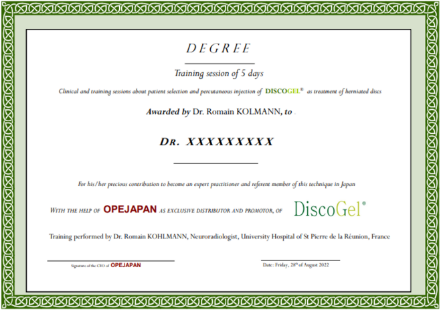
"Very good or good results were obtained in 202 (91.4%) of the 221 patients in group A. Of the 44 patients in group B, 37 patients (84%) presented very good or good results and in 9 (82%) of the 11 patients of group C, we obtained similar results. There was no allergic complication in any of our patients. Long-term follow-up magnetic resonance showed a dramatic reduction in hernia volume."
- Dr. J. Theron, one of the world's leading experts in the treatment of Celgel method, from his research article "Percutaneous Treatment of Lumbar Intervertebral Disk Hernias With Radiopaque Gelified Ethanol - A preliminary study."
Merits of Cellgel
- Possibility to repair intervertebral discs where unable to using surgical or laser treatment
- As the disc is repaired, the disc itself regains its original normal function through its own regenerative ability
- The Cellgel method uses local anesthesia over general anesthesia used in conventional surgery, making it less burdensome on the body
- Treatment is done with a thin needle, so the wound is minimal and recovery is rapid
- Treatment is very short, allowing for outpatient day treatment
- Safe, modern treatment proven in more than 54 countries around the world
Flow Cellgel Treatment Process
-
01 Examination

MRI and X-rays will be taken, followed by a doctor's diagnosis.
If the diagnosis proves the Cellgel method suitable, treatment can begin that same afternoon. -
02 Before

TreatmentAfter entering the treatment room and administering local anesthesia to the lower back, a needle is inserted into the intervertebral disc identified in the examination.
A contrast scan is performed to confirm the location of the damaged disc. -
03 Treatment
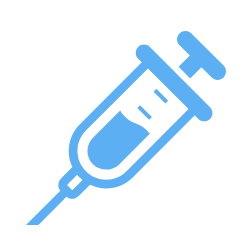
The Cellgel drug is administered to the damaged area while confirming the location of the disc with a fluoroscopy device.
Once the drug has been absorbed, the needle is removed and the bleeding is stopped.
-
04 Returning

HomeAfter the treatment, the patient rests in a private room for about an hour, and then allowed to go home after the post-treatment examination.
*Resting time depends on the patient's symptoms and condition.
Price Cost of Treatment for the Cellgel Method
| Number of Discs Treated |
1 disc | 2 discs | 3 discs | 4 discs | 5 discs |
|---|---|---|---|---|---|
| Treatment Cost | 1,320,000 JPY | 1,430,000 JPY | 1,540,000 JPY | 1,650,000 JPY | 1,760,000 JPY |
Swipe left/righ
* The cost of treatment is indicated including taxes.
*If treatment is performed at our clinic, all examination/diagnosis costs and test costs such as MRI are included in the above costs.
*This treatment method is not covered by Japanese health insurance, so you will have to pay for the entire treatment yourself.
*Payment by credit card (VISA, MasterCard, JCB, American Express, Diners, Discover) is also possible.
*If you would like rehabilitation (low back pain specialized rehabilitation), it is also possible to pay by bank transfer.
*If you live and work in Japan, you can receive a tax refund by filing your final medical expense return.
FAQ Questions about disc degeneration and treatment
-
QWhat's the difference in the reccurence rate between Cellgel and conventional surgery?
-
A
Surgical procedures, which began in the 1960s, aimed to remove and sometimes fix deformed bones and herniated tissue. However, new bone damage caused by screws and the lack of fundamental treatment (repair of the intervertebral disc annulus fibrosus) resulted in the appearance of additional back pain and recurrence rates.
Therefore, in the 1980s, the need for fundamental treatment increased, and the intervertebral disc treatment (Cellgel) that we provide at our clinic began. Cellgel, in particular, have been proven to repair and regenerate the intervertebral disc, resulting in not only improvement of symptoms, but also an extremely low recurrence rate.
-
QHow is the disc to be treated determined?
-
AThe doctor will spend about 30 minutes with the patient while looking at the MRI and X-ray images to determine the cause of the condition, determine the treatment area, and explain the corresponding treatment method to the patient. MRI images show the main factors that contribute to back pain (disc, nerve, ligament, and joint), such as changes in shape, pressure on the nerve, presence or absence of damage, and inflammation. The x-ray image mainly confirms the condition of the bones.
-
QWhy is the Cellgel method applicable to cases where surgery showed no improvement?
-
ADuring surgery for disc degeneration, the prolapsed herniation is removed, but the damaged disc remains intact. As a result, fresh nucleus pulposus components leak from the damaged disc and inflammation persists. On the other hand, our treatment can treat the disc injury itself, thus suppressing inflammation by reducing the fresh leakage of nucleus pulposus components.
-
QMy back pain may temporarily worsen after treatment. How long will it last?
-
AThe reason for the lower back pain is that spinal ligaments that have been compressed are stretched; the lower back pain lasts for about two weeks and then subsides.
-
QWhat level of exercise can I perform after treatment?
-
AGeneral recreational exercise and sports can be done without any problem. For professional athletes, the possibility of new disc damage is high and should be discussed in consultation with a doctor.
-
QPlease tell me about what I should be cautious about after treatment.
-
ADuring the first few days after treatment, the patient should rest and avoid prolonged sitting, heavy lifting, twisting, bending, or strenuous exercise. Patients should be able to perform routine tasks one week after treatment and should be able to perform light exercise by the second week. Weight training is allowed after 3 months.
-
QIs the treatment covered by the Japanese national health insurance?
-
ANo, it is not covered by the national insurance. If you have life insurance, you may be eligible. Please feel free to consult our staff regarding this matter.
-
QHow long must I wait to be able to walk after treatment?
-
AIt is an outpatient/day treatment, so you can walk about an hour after the surgery.
-
QHow many doctor visits do I need to make before treatment?
-
AWe require an MRI to be taken within three months for remote diagnosis, either with our affiliated clinic or from data sent by you. You can receive treatment on the same day after phyiscal diagnosis. You may also request only the diagnosis and come back only for the treatment at a later date.
-
QCan I fly immediately after the treatment?
-
AIf there are no problems after the treatment, you may fly. If there is any pain after the treatment, flying may not be recommended depending on the doctor's evaluation.
-
QWhat should I be cautious about when I'm diagnosed with disc degeneration?
-
AFirst, if the current pain and other symptoms are fairly severe, try resting and observing the symptoms for about a week. If there is no improvement in symptoms after a month, we recommend that you visit a local orthopedic clinic or hospital.
-
QCan a degenerated disc return to its original state without surgery?
-
AIf the damage to the disc is minor, it may heal naturally. When the wound closes on its own, the moisture inside the disc increases and the disc performs its intended function.
However, if the wound is deep and the annulus fibrosus is damaged, self-healing is often difficult, and if it worsens, it may lead to disc herniation or degenerative spondylolisthesis. In such cases, the Cellgel method may be the recommended treatment.
-
QWhat's the difference between disc herniation and disc degeneration?
-
A
Disc degeneration is a condition in which the disc is cracked or damaged, causing it to lose water content, become hard, lose its cushioning function, and begin to deform, resulting in back pain.
Disc herniation is when the nucleus pulposus leaks from the damaged area and compresses the nerves.As disc degeneration worsens, the likelihood of a herniated disc increases.
-
QIs there anything I can do to prevent disc damage?
-
AAlthough disc damage is said to be caused by aging and other factors, the strain on the lower back caused by daily posture and movement is also significant. In particular, prolonged sitting puts considerable strain on the lower back. Therefore, we recommend that you take care of your posture and sitting posture on a daily basis, as well as training at home.
-
QIf the disc deforms again after treatment at this clinic, is it possible to undergo treatment again?
-
AYes, it is possible. With the Cellgel method, re-treatment is possible because the treatment promotes the repair and regeneration of the intervertebral disc. However, deformation of the disc after treatment with the Cellgel method is most likely to occur when a lot of pressure is applied, i.e. stenuous sports or heavy labor requiring continuous straining. After treatment, we also consider future prevention and provide exercise guidance and home training, or one-on-one rehabilitation through our back pain-specific rehabilitation program.
-
QHow long do I have to rest after treatment for disc degeneration?
-
AThe period of rest varies from person to person, but the patient can gradually return to his/her daily activities while monitoring his/her condition.
-
QIf I have disc degeneration, is there any exercise that I avoid?
-
AAvoid movements that involve excessive use of the lower back or heavy lifting. Strenuous exercise can also cause further disc degeneration, so please be sure to adopt an appropriate exercise regimen.
ILC Rehabilitation X Disc Degeneration Treatment
Although the Cellgel method can repair and regenerate the disc itself, and other treatment methods we offer can fundamentally heal the disc; it is possible that the cause of back pain is not only the disc, but also muscles, joints, and ligaments that are affected by the disc.
In cooperation with our rehabilitation specialists, we recommend treating back pain caused by muscles, joints, and ligaments together.
We also offer a short-term intensive program for patients who live far away or overseas.
-
ILC's Low Back Pain Treatment
Outpatient Treatment
Improve back pain disorders/
symptoms in relation to the nerves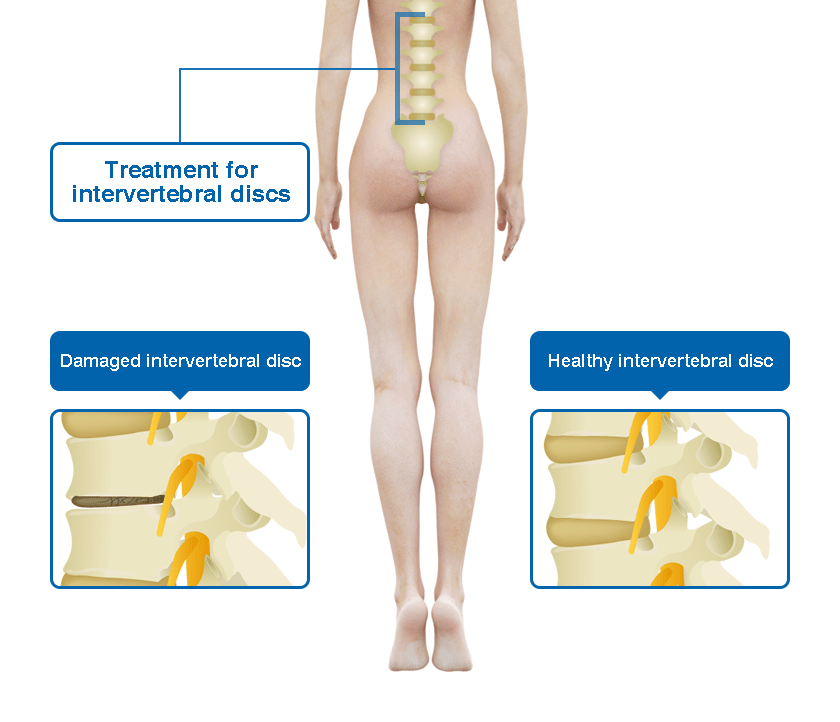
-
ILC's Rehabilitation Program
Specialized Low Back Pain Rehabilitation
Improve back pain disorders/symptoms in
relation to the joints, muscles, ligaments
-
01
ILC's Specialized Back Pain Rehabilitation
Our Rehabilitation Approach to Disc Degeneration
It has been found that the risk of disc degeneration is related to repeated mechanical stresses such as excessive compression on the disc, aging, lifestyle factors such as smoking and diet, and oxidative stress.
Although rehabilitation is possible even when the cushioning function is impaired, rehabilitation cannot repair disc fissures or enhance the cushioning function, and can only prevent the disc from degenerating further by decreasing burden on the disc.
Therefore, at our rehabilitation center, we believe it is very important to both repair the function of the intervertebral disc and then conduct rehabilitation to prevent recurrence.
In addition, our rehabilitation program also includes a review of lifestyle, such as diet, to prevent the deterioration of intervertebral discs. -
02
ILC's Specialized Back Pain Rehabilitation
How to Evaluate Disc Degeneration
To understand the site of the damage caused by disc degeneration, the degree of damage and the condition of surrounding tissue, a consultation with the doctor will be conducted based on the image (MRI) findings. After understanding the condition, we will conduct a medical interview and physical evaluation.
During the interview, we will ask not only about the patient's physical condition, but also about lifestyle and dietary habits.
During the physical evaluation, the doctor will slowly move the patient's body in order to find out the areas that are under strain due to disc degeneration and to find out the movements and postures that have caused the disc to become overloaded.
If necessary, we also use a machine to evaluate the oxidative stress level.
-
03
ILC's Specialized Back Pain Rehabilitation
Rehabilitation Treatment for Disc Degeneration
There are two main types of treatment methods for intervertebral disc degeneration:
-
Acupuncture and exercise therapy
To alleviate pressure on the disc
- Heat therapy to improve blood circulation around pain points
- Acupuncture for local pain relief and soft tissue lubrication throughout the body
- Postural improvement and core training
-
Dietary Guidance
When disc degeneration is progressing, the disc is prone to irritate the nerves that cause pain. In addition to excessive stress, such a condition causes excessive production of reactive oxygen species (ROS).
ROS is a partially activated form of oxygen taken into the body. While ROS work as a cellular transmitter and immune function, excessive production of ROS is a substance that is greatly related to lifestyle-related diseases such as cancer and cardiovascular diseases. The state of excessive presence of reactive oxygen species in the body is called oxidative stress.Reactive oxygen species cause oxidation and damage to intervertebral discs. Antioxidant supplementation is necessary to control oxidative stress levels to normal levels.
Recent studies have proven that enzyme intake reduces oxidative stress better than the typical antioxidants, vitamins A, C, and E.Since oxidative stress causes disc degeneration, which is the cause of herniated discs and spinal canal stenosis, our facility offers therapeutic diets (such as brown rice meals and enzyme drinks) as part of our residential rehabilitation program.
-
Acupuncture and exercise therapy
-
04
ILC's Specialized Back Pain Rehabilitation
Treatment Period for Disc Degeneration Rehabilitation
Although it varies from each individual, inflammation from disc degeneration tends to ease in about one to two weeks after the Cellgel method combined with rehabilitation.
Even if surgery is performed, there is a possibility of recurrence. Although aging plays a major role in degeneration, diet and posture habits need to be improved as a whole. It takes at least 3 months for the body to physically change upon consistent posture and diet improvements, such as enzyme intake. Since daily and consistency is the key to pain relief, many people use our residential rehabilitation as an opportunity to improve their eating habits and reduce smoking.
Our facility also has a dietitian on staff, so we aim to improve the body and nutrition habit under the guidance of these experts.
We aim to achieve 100% effectiveness of treatment while incorporating the latest technology, so we spend at least 30 minutes with each patient to carefully and meticulously examine the patient's concerns in order to make a proper diagnosis and propose the most suitable treatment methods.
We are certain to find a way to alleviate or eliminate the pain and numbness you are experiencing, so please do not give up and give us a call instead!
- Tadaaki Minowa, Clinic Director



